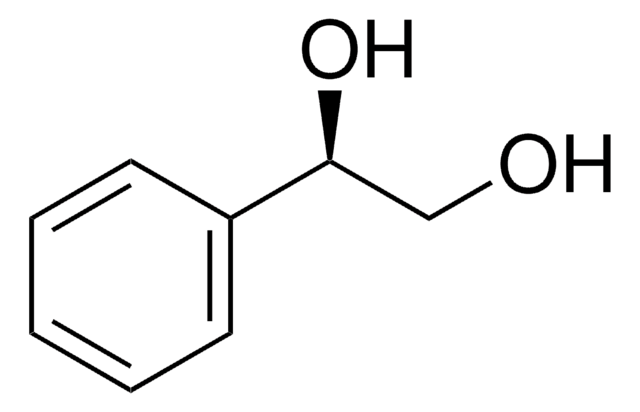P24055
1-Phenyl-1,2-ethanediol
97%
Synonym(s):
(±)-1-Phenyl-1,2-ethanediol, (±)-Phenylethylene glycol
Sign Into View Organizational & Contract Pricing
All Photos(3)
About This Item
Linear Formula:
C6H5CH(OH)CH2OH
CAS Number:
Molecular Weight:
138.16
Beilstein:
1306723
EC Number:
MDL number:
UNSPSC Code:
12352100
PubChem Substance ID:
NACRES:
NA.22
Recommended Products
Quality Level
Assay
97%
form
solid
bp
272-274 °C/760 mmHg (lit.)
mp
66-68 °C (lit.)
SMILES string
OCC(O)c1ccccc1
InChI
1S/C8H10O2/c9-6-8(10)7-4-2-1-3-5-7/h1-5,8-10H,6H2
InChI key
PWMWNFMRSKOCEY-UHFFFAOYSA-N
Looking for similar products? Visit Product Comparison Guide
Storage Class Code
11 - Combustible Solids
WGK
WGK 3
Flash Point(F)
Not applicable
Flash Point(C)
Not applicable
Personal Protective Equipment
dust mask type N95 (US), Eyeshields, Gloves
Choose from one of the most recent versions:
Already Own This Product?
Find documentation for the products that you have recently purchased in the Document Library.
Customers Also Viewed
Ashwini C Mathpati et al.
Journal of biotechnology, 262, 1-10 (2017-09-30)
Kinetic resolution of rac-1,2-diols using the biocatalyst Burkholderia cepacia lipase (BCL) immobilized on a biodegradable binary blend support of hydroxypropyl methyl cellulose(HPMC)/polyvinyl alcohol (PVA) has been investigated. The immobilization technique improved enzyme activity significantly and it has excellent recyclability with
Qingsen Hu et al.
Bioresource technology, 101(21), 8461-8463 (2010-06-25)
In this study, a highly efficient process for Candida parapsilosis-catalyzed deracemization of racemic 1-phenyl-1,2-ethanediol (PED) was described, based on a resin-based in situ substrate feeding and product removal (ISSFPR) methodology. The resin H103 was selected and used to keep the
Pablo Taboada et al.
Langmuir : the ACS journal of surfaces and colloids, 21(12), 5263-5271 (2005-06-01)
Three triblock copolymers of ethylene oxide and phenyl glycidyl ether, type E(m)G(n)E(m), where G = OCH2CH(CH2OC6H5) and E = OCH2CH2, were synthesized and characterized by gel-permeation chromatography, matrix-assisted laser desorption ionization time-of-flight mass spectrometry, and NMR spectroscopy. Their association properties
Hee Sook Kim et al.
Biotechnology letters, 30(1), 127-133 (2007-08-01)
Enantio-convergent hydrolysis of racemic styrene oxides was achieved to prepare enantiopure (R)-phenyl-1,2-ethanediol by using two recombinant epoxide hydrolases (EHs) of a bacterium, Caulobacter crescentus, and a marine fish, Mugil cephalus. The recombinant C. crescentus EH primarily attacked the benzylic carbon
Cesar Mateo et al.
Analytical biochemistry, 314(1), 135-141 (2003-03-14)
In this paper we report the development of a novel and simple spectrophotometric assay which allows one to achieve the continuous, rapid, sensitive, and accurate determination of an epoxide hydrolase activity. This assay is based on the elaboration of a
Our team of scientists has experience in all areas of research including Life Science, Material Science, Chemical Synthesis, Chromatography, Analytical and many others.
Contact Technical Service










